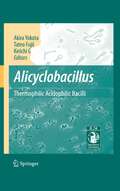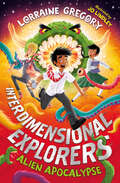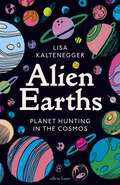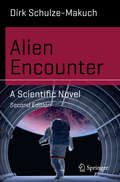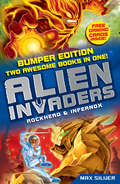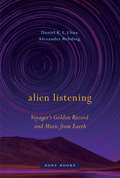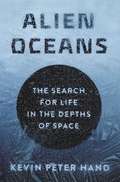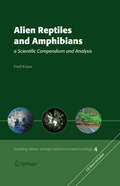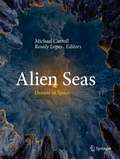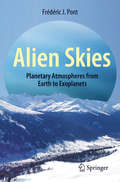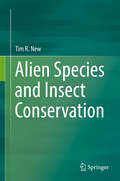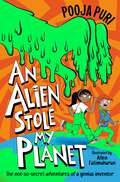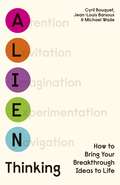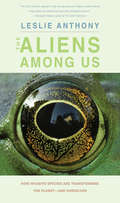- Table View
- List View
Alicyclic Chemistry
by V.K. Ahluwalia Renu AggarwalThis textbook is intended for undergraduate and postgraduate students in organic chemistry. It describes the synthesis and properties of cycloalkanes compounds such as cyclopropane, cyclobutane, cyclopentane, cyclohexane, cycloheptane and cycloheptatriene. It further covers the chemistry of ring compounds. The book also covers the reaction mechanisms of non-benzenoid aromatic compounds including annulenes, metallocenes and azulenes. It further contains discussions on tropone, tropolones, fluxional molecules, catenanes and rotaxanes. End-of-chapter exercises such as multiple-choice questions and short answer-questions help students in self-learning. This textbook is useful for undergraduate and postgraduate students in organic chemistry.
Alicyclobacillus: Thermophilic Acidophilic Bacilli
by A. Yokota T. Fujii K. GotoAlicyclobacillus are not pathogenic bacteria, but they are troublesome, not only for consumers but also for beverage producers, because no effective control methods have yet been developed. It is against this background and in recognition of the importance and urgency of the problem that this book brings together new insights on the topic together with research published to date. The book uniquely focuses on one genus of bacteria. It aims to bring the information of Alicyclobacillus together and offer helpful understanding to control the bacteria for food industries.
Alien Apocalypse (Interdimensional Explorers)
by Lorraine GregoryThe second sensational book in a brand-new funny, accessible and action-packed space-adventure series written by the incredible Lorraine Gregory – perfect for middle grade fans of MG Leonard and David Baddiel!
The Alien Communication Handbook: So We Received a Signal—Now What? (Astronomers' Universe)
by Brian S. McConnellScientists have been searching for signals from extraterrestrial civilizations since Frank Drake’s first radio survey in 1960. But what would actually happen if SETI’s search succeeds? Is there any way we could even make sense of the signal we receive? Written by an expert in communication systems and translation technology, this book explores the science of interstellar communication. It explains how this process may unfold, how an ET communication link would work, the types of information it could convey and how professionals, amateurs and ordinary people like you would participate in the effort to understand what another civilization has to say. Along the way, the book introduces readers to many aspects of modern-day communication systems and computing. Featured as well are dozens of illustrations, photos and real-world examples, rounding out this compelling foray into the mechanics of interstellar communication. “Scientists, policy makers, and all interested in the likely future discovery of alien life will want to read this book.” - Steven J. Dick, Former NASA Chief Historian
Alien Earths: Planet Hunting in the Cosmos
by Lisa Kaltenegger‘Lisa Kaltenegger offers first-hand access to her expertise on the search for planets in the universe, and the life they may contain. Along the way, Lisa's breezy narrative style invites you to experience with her the challenges and joys of being a scientist on the frontier of discovery’ Neil deGrasse Tyson, AstrophysicistFor thousands of years, humans have wondered whether we're alone in the cosmos. Now, for the first time, we have the technology to investigate. The question should have an obvious answer: yes or no. But once you try to find life elsewhere, you realize it is not so simple. How do you find it over cosmic distances? What actually is life?Astronomer Lisa Kaltenegger works from Carl Sagan’s former office at Cornell University, where she built a team of tenacious scientists from many disciplines to find life on faraway worlds, using Earth’s diverse biosphere and its history as a Rosetta Stone. With infectious enthusiasm, she provides an eye-opening insider’s guide to the most unusual exoplanets that have shaken our worldview – planets covered in oceans of lava, lonely wanderers lost in space, and others with more than one sun in their sky – as well as the best contenders for Alien Earths. She also shows how close imagined scifi worlds come to reality.We live in an incredible new epoch of exploration. As our witty and knowledgeable tour guide, Professor Kaltenegger shows how we discover not merely new continents, like the explorers of old, but whole new worlds circling other stars – and how we could spot life there. Worlds from where aliens may even be gazing back at us. What if we're not alone?
Alien Encounter: A Scientific Novel (Science and Fiction)
by Dirk Schulze-MakuchIt has been nearly 100 years since the Apollo moon landings, when Jack and Vladimir, two astronauts on a mission to Venus, discover a mysterious void related to indigenous life on the planet. Subsequently more voids are detected on Earth, Mars, Titan, and, quite ominously, inside a planetoid emerging from the Kuiper belt.Jack is sent to investigate the voids in the Solar System and intercept the planetoid - which, as becomes increasingly clear, is inhabited by alien life forms. Jack and his crew will have little time to understand their alien biochemistry, abilities, behavior patterns, resilience, and technology, but also how these life forms relate to the voids.Humankind's first encounter with these exotic life forms couldn't be more fateful, becoming a race against time to save life on Earth and to reveal the true nature of the voids, which seem to be intrinsically related to life and the universe itself. In this novel, the author combines many topics related to state-of-the-art research in the field of astrobiology with fictional elements to produce a thrilling page turner.This new version significantly develops the astrobiological denouement of the plot and features an extensive non-technical appendix where the underlying science is presented and discussed.From the reviews of the first edition (Voids of Eternity: Alien Encounter)Here's a thrilling yarn in the best "hard SF" tradition of Asimov, James Hogan, and Ben Bova, written by a scientist who knows all about the possibilities of life in the solar system and beyond. Dirk Schulze-Makuch weaves into his book all the astrobiological themes he's worked on in recent years -- speculation about creatures in the atmosphere of Venus and on and under the surface of Mars and Titan -- together with some well-informed Eastern philosophy and a cracking good space battle. A great first novel from a rising talent. Highly recommended. David Darling, on amazon.com, 2009The research interests of Dr. Schulze-Makuch, currently a professor at Washington State University, focus on evolutionary adaptation strategies of organisms in their natural environment, particularly extreme environments such as found on other planetary bodies. Dirk Schulze-Makuch is best known for his publications on extraterrestrial life, being coauthor of three books on the topic: We Are Not Alone: Why We Have Already Found Extraterrestrial Life (2010), Cosmic Biology: How Life could Evolve on Other Worlds (2010), and Life in the Universe: Expectations and Constraints (2004). In 2011 he published with Paul Davies A One Way Mission to Mars: Colonizing the Red Planet and in 2012 with David Darling Megacatastrophes! Nine Strange Ways the World Could End.
Alien Gene Transfer in Crop Plants, Volume 1: Innovations, Methods and Risk Assessment
by Aditya Pratap Jitendra KumarGenetic engineering and biotechnology along with conventional breeding have played an important role in developing superior cultivars by transferring economically important traits from distant, wild and even unrelated species to the cultivated varieties which otherwise could not have been possible with conventional breeding. There is a vast amount of literature pertaining to the genetic improvement of crops over last few decades. However, the wonderful results achieved by crop scientists in food legumes’ research and development over the years are scattered in different journals of the World. The two volumes in the series ‘Alien Gene Transfer in Crop Plants’ address this issue and offer a comprehensive reference on the developments made in major food crops of the world. These volumes aim at bringing the contributions from globally renowned scientists at one platform in a reader-friendly manner. The 1st volume entitled, ‘Alien Gene Transfer in Crop Plants: Innovations, Methods and Risk Assessment” will deal exclusively with the process and methodology. The contents of this volume have been designed to appraise the readers with all the theoretical and practical aspects of wide hybridization and gene transfer like processes and methods of gene transfer, role of biotechnology with special reference to embryo rescue, genetic transformation, protoplast fusion and molecular marker technology, problems such as cross incompatibility and barriers to distant hybridization and solutions to overcome them. Since wild and weedy relatives of crop plants may have negative traits associated with them, there are always possibilities of linkage drag while transferring alien alleles. Therefore, problems and limitations of alien gene transfer from these species will also be discussed in this series. Further, the associated risks with this and assessment of risks will also be given due weightage.
Alien Gene Transfer in Crop Plants, Volume 2: Achievements and Impacts
by Aditya Pratap Jitendra KumarGenetic engineering and biotechnology along with conventional breeding have played an important role in developing superior cultivars by transferring economically important traits from distant, wild and even unrelated species to the cultivated varieties which otherwise could not have been possible with conventional breeding. There is a vast amount of literature pertaining to the genetic improvement of crops over last few decades. However, the wonderful results achieved by crop scientists in food legumes’ research and development over the years are scattered in different journals of the World. The two volumes in the series ‘Alien Gene Transfer in Crop Plants’ address this issue and offer a comprehensive reference on the developments made in major food crops of the world. These volumes aim at bringing the contributions from globally renowned scientists at one platform in a reader-friendly manner. The second volume entitled, “Alien Gene Transfer in Crop Plants: Achievements and Impact” will deal more with the practical aspects. This volume will cover achievements of alien gene transfer in major food crops of the world and their impact on development of newer genetic variability and additional avenues for selection; development of superior cultivars for increased yield, resistance to biotic and abiotic stresses, improved nutritional and industrial quality; innovation of new techniques and positive as well as negative environmental implications. This volume has been divided into four groups with an aim to cover all major cereals, pulses, oilseeds and other crops (vegetable and horticultural crops) which are of economic importance.
Alien Introgression in Wheat: Cytogenetics, Molecular Biology, and Genomics
by Márta Molnár-Láng Carla Ceoloni Jaroslav DoleželThis book provides an overview of the latest advancements in the field of alien introgression in wheat. The discovery and wide application of molecular genetic techniques including molecular markers, in situ hybridization, and genomics has led to a surge in interspecific and intergeneric hybridization in recent decades. The work begins with the taxonomy of cereals, especially of those species which are potential gene sources for wheat improvement. The text then goes on to cover the origin of wheat, breeding in connection with alien introgressions, and the problems of producing intergeneric hybrids and backcross derivatives. These problems can include crossability, sterility, and unequal chromosome transmission. The work then covers alien introgressions according to the related species used, as well as new results in the field of genomics of wild wheat relatives and introgressions.
Alien Invaders: Two Book Bind-up (2 Books in #1)
by Max SilverDiscover the explosive world of Alien Invaders in this awesome introduction to the series - featuring Cosmo's first two adventures in full! Travel at hyperspeed to the moon of Garr where you will battle the first invader ROCKHEAD, the living mountain. Then, fly your own Dragster 7000 spaceship to the jungle planet of Zaman, where you will battle the second invader INFERNOX, the firestarter!Complete with bonus games and puzzles - and fantastic gaming cards that allow you to do battle alongside Cosmo!
Alien Listening: Voyager's Golden Record and Music from Earth
by Daniel K. Chua Alexander RehdingAn examination of NASA's Golden Record that offers new perspectives and theories on how music can be analyzed, listened to, and thought about—by aliens and humans alike.In 1977 NASA shot a mixtape into outer space. The Golden Record aboard the Voyager spacecrafts contained world music and sounds of Earth to represent humanity to any extraterrestrial civilizations. To date, the Golden Record is the only human-made object to have left the solar system. Alien Listening asks the big questions that the Golden Record raises: Can music live up to its reputation as the universal language in communications with the unknown? How do we fit all of human culture into a time capsule that will barrel through space for tens of thousands of years? And last but not least: Do aliens have ears?The stakes could hardly be greater. Around the extreme scenario of the Golden Record, Chua and Rehding develop a thought-provoking, philosophically heterodox, and often humorous Intergalactic Music Theory of Everything, a string theory of communication, an object-oriented ontology of sound, and a Penelopean model woven together from strands of music and media theory. The significance of this exomusicology, like that of the Golden Record, ultimately takes us back to Earth and its denizens. By confronting the vast temporal and spatial distances the Golden Record traverses, the authors take listeners out of their comfort zone and offer new perspectives in which music can be analyzed, listened to, and thought about—by aliens and humans alike.
Alien Listening: Voyager's Golden Record and Music from Earth
by Daniel K. Chua Alexander RehdingAn examination of NASA's Golden Record that offers new perspectives and theories on how music can be analyzed, listened to, and thought about—by aliens and humans alike.In 1977 NASA shot a mixtape into outer space. The Golden Record aboard the Voyager spacecrafts contained world music and sounds of Earth to represent humanity to any extraterrestrial civilizations. To date, the Golden Record is the only human-made object to have left the solar system. Alien Listening asks the big questions that the Golden Record raises: Can music live up to its reputation as the universal language in communications with the unknown? How do we fit all of human culture into a time capsule that will barrel through space for tens of thousands of years? And last but not least: Do aliens have ears?The stakes could hardly be greater. Around the extreme scenario of the Golden Record, Chua and Rehding develop a thought-provoking, philosophically heterodox, and often humorous Intergalactic Music Theory of Everything, a string theory of communication, an object-oriented ontology of sound, and a Penelopean model woven together from strands of music and media theory. The significance of this exomusicology, like that of the Golden Record, ultimately takes us back to Earth and its denizens. By confronting the vast temporal and spatial distances the Golden Record traverses, the authors take listeners out of their comfort zone and offer new perspectives in which music can be analyzed, listened to, and thought about—by aliens and humans alike.
Alien Oceans: The Search for Life in the Depths of Space
by Kevin HandInside the epic quest to find life on the water-rich moons at the outer reaches of the solar systemWhere is the best place to find life beyond Earth? We often look to Mars as the most promising site in our solar system, but recent scientific missions have revealed that some of the most habitable real estate may actually lie farther away. Beneath the frozen crusts of several of the small, ice-covered moons of Jupiter and Saturn lurk vast oceans that may have been in existence for as long as Earth, and together may contain more than fifty times its total volume of liquid water. Could there be organisms living in their depths? Alien Oceans reveals the science behind the thrilling quest to find out.Kevin Peter Hand is one of today's leading NASA scientists, and his pioneering research has taken him on expeditions around the world. In this captivating account of scientific discovery, he brings together insights from planetary science, biology, and the adventures of scientists like himself to explain how we know that oceans exist within moons of the outer solar system, like Europa, Titan, and Enceladus. He shows how the exploration of Earth's oceans is informing our understanding of the potential habitability of these icy moons, and draws lessons from what we have learned about the origins of life on our own planet to consider how life could arise on these distant worlds.Alien Oceans describes what lies ahead in our search for life in our solar system and beyond, setting the stage for the transformative discoveries that may await us.
The Alien Perspective: A New View of Humanity and the Cosmos
by David WhitehouseAstronomer and science writer David Whitehouse takes us on a journey through the evolving cosmos as he considers humankind's place in the universe - and how our survival depends on otherworldly perspectives.From the Earth to the depths of outer space, this inspiring book shows how human evolution has been intertwined with the workings of the cosmos from the very beginning, and what the far-distant future may hold, both for the universe and for ourselves.Given enough time, Whitehouse contends, we must communicate with intelligent aliens whose divergent perspective will transform our understanding of the universe. First contact may even come sooner than we think. We have already transmitted signals towards promising exoplanets. If, say, Gliese 581d harbours life, the return signal could reach us in 2051.Drawing the thread of human consciousness from the cave to the cosmos, the acclaimed author of Apollo 11: The Inside Story charts our future journey to the end of space and time and considers whether something of humanity could remain at the end of it all.
Alien Reptiles and Amphibians: a Scientific Compendium and Analysis (Invading Nature - Springer Series in Invasion Ecology #4)
by Fred KrausTransportation of species to areas outside their native ranges has been a feature of human culture for millennia. During this time such activities have largely been viewed as beneficial or inconsequential. However, it has become increasingly clear that human-caused introductions of alien biota are an ecological disruption whose consequences rival those of better-known insults like chemical pollution, habitat loss, and climate change. Indeed, the irreversible nature of most alien-species int- ductions makes them less prone to correction than many other ecological problems. Current reshuffling of species ranges is so great that the present era has been referred to by some as the “Homogocene” in an effort to reflect the unique mag- tude of the changes being made. These alien interlopers often cause considerable ecological and economic d- age where introduced. Species extinctions, food-web disruptions, community alte- tions, ecosystem conversion, changes in nutrient cycling, fisheries collapse, watershed degradation, agricultural loss, building damage, and disease epidemics are among the destructive – and frequently unpredictable – ecological and economic effects that invasive alien species can inflict. The magnitude of these damages c- tinues to grow, with virtually all environments heavily used by humans now do- nated by alien species and many “natural” areas becoming increasingly prone to alien invasion as well. Attention to this problem has increased in the past decade or so, and efforts to prevent or limit further harm are gaining wider scientific and political acceptance.
Alien Seas: Oceans in Space
by Michael Carroll and Rosaly LopesOceans were long thought to exist in all corners of the Solar System, from carbonated seas percolating beneath the clouds of Venus to features on the Moon's surface given names such as "the Bay of Rainbows” and the "Ocean of Storms." With the advent of modern telescopes and spacecraft exploration these ancient concepts of planetary seas have, for the most part, evaporated. But they have been replaced by the reality of something even more exotic. For example, although it is still uncertain whether Mars ever had actual oceans, it now seems that a web of waterways did indeed at one time spread across its surface. The "water" in many places in our Solar System is a poisoned brew mixed with ammonia or methane. Even that found on Jupiter's watery satellite Europa is believed similar to battery acid. Beyond the Galilean satellites may lie even more "alien oceans." Saturn's planet-sized moon Titan seems to be subject to methane or ethane rainfall. This creates methane pools that, in turn, become vast lakes and, perhaps, seasonal oceans. Titan has other seas in a sense, as large shifting areas of sand covering vast plains have been discovered. Mars also has these sand seas, and Venus may as well, along with oceans of frozen lava. Do super-chilled concoctions of ammonia, liquid nitrogen, and water percolate beneath the surfaces of Enceladus and Triton? For now we can only guess at the possibilities. 'Alien Seas' serves up part history, part current research, and part theory as it offers a rich buffet of "seas" on other worlds. It is organized by location and by the material of which various oceans consist, with guest authors penning specific chapters. Each chapter features new original art depicting alien seas, as well as the latest ground-based and spacecraft images. Original diagrams presents details of planetary oceans and related processes.
Alien Skies: Planetary Atmospheres from Earth to Exoplanets
by Frédéric J. PontPlanetary atmospheres are complex and evolving entities, as mankind is rapidly coming to realise whilst attempting to understand, forecast and mitigate human-induced climate change. In the Solar System, our neighbours Venus and Mars provide striking examples of two endpoints of planetary evolution, runaway greenhouse and loss of atmosphere to space.The variety of extra-solar planets brings a wider angle to the issue: from scorching "hot jupiters'' to ocean worlds, exo-atmospheres explore many configurations unknown in the Solar System, such as iron clouds, silicate rains, extreme plate tectonics, and steam volcanoes. Exoplanetary atmospheres have recently become accessible to observations.This book puts our own climate in the wider context of the trials and tribulations of planetary atmospheres. Based on cutting-edge research, it uses a grand tour of the atmospheres of other planets to shine a new light on our own atmosphere, and its relation with life.
Alien Species and Insect Conservation
by Tim R. NewThis overview of the roles of alien species in insect conservation brings together information, evidence and examples from many parts of the world to illustrate their impacts (often severe, but in many cases poorly understood and unpredictable) as one of the primary drivers of species declines, ecological changes and biotic homogenisation. Both accidental and deliberate movements of species are involved, with alien invasive plants and insects the major groups of concern for their influences on native insects and their environments. Risk assessments, stimulated largely through fears of non-target impacts of classical biological control agents introduced for pest management, have provided valuable lessons for wider conservation biology. They emphasise the needs for effective biosecurity, risk avoidance and minimisation, and evaluation and management of alien invasive species as both major components of many insect species conservation programmes and harbingers of change in invaded communities. The spread of highly adaptable ecological generalist invasive species, which are commonly difficult to detect or monitor, can be linked to declines and losses of numerous localised ecologically specialised insects and disruptions to intricate ecological interactions and functions, and create novel interactions with far-reaching consequences for the receiving environments. Understanding invasion processes and predicting impacts of alien species on susceptible native insects is an important theme in practical insect conservation.
An Alien Stole My Planet
by Pooja PuriAn Alien Stole My Planet is a laugh-out-loud, wacky adventure through space by Pooja Puri, brilliantly illustrated by Allen Fatimaharan. It is the third book in the A Dinosaur Ate My Sister series.Before you start reading, there are a few things you should know:1. I, Esha Verma, am a genius inventor extraordinaire.2. I like lists.3. I did not mean to open up an inter-galactic portal. Some things just can't be helped.Esha Verma, her snotty apprentice Broccoli and his secretly cunning pet tortoise are on their third adventure – this time it's an inter-galactic mission through outer-space to stop an alien from stealing their planet!When Esha invents the Inviz-Whiz, a device designed to make the user invisible, she does not expect it to open a portal to outer space – and things go from bad to worse when Esha, Broccoli, Archibald and Broccoli's annoying cousin Bean are immediately abducted by Goospa, an alien with an evil plan!With the help of a surly alien called Nix, Esha and the gang must race across the galaxy, navigate a Lava Marsh, fight vicious Ice Bats – and stop Bean getting into too much trouble! – to stop Goospa's plan before it's too late!
Alien Thinking: How to Bring Your Breakthrough Ideas to Life
by Michael Wade Jean-Louis Barsoux Cyril Bouquet'Stuck in innovation stagnation? Read this brilliant book, and you'll break free from it' Rolf Dobelli, author of the million-copy bestseller The Art of Thinking Clearly How did a balloonist circumnavigate the earth without fuel? How did an inventor design a device that creates electrical power from human footsteps? How did the WHO figure out how to treat and reduce the transmission of Ebola? They all used ALIEN THINKING.________________ For over a decade, innovation experts Cyril Bouquet, Jean-Louis Barsoux and Michael Wade have studied individuals around the world who have made leaps of creative genius. Their research shows that they are five patterns of thinking that distinguish true innovators from the rest of us. These five patterns are marked by a flexibility and a freshness of approach that transcends conventional problem-solving:- Attention- Levitation- Imagination- Experimentation- NavigationAlien thinkers know how to free their imagination and detect hard-to-observe patterns. They practice deliberate ways to retreat from the world in order to see the big picture underlying a problem. And they prototype ideas in systematic ways to reflect feedback and the constraints of reality. Alien Thinking will help you innovate better and develop world-changing ideas of your own.________________'A sharp critique of the conventional wisdom around innovation with thought-provoking advice for how to do it better' Jake Knaap, New York Times-bestselling author'Compelling insights and powerful illustrations to enhance the innovation process' Alex Osterwalder, author of the two-million copy bestseller Business Model Generation
Alien Universe: Extraterrestrial Life in Our Minds and in the Cosmos
by Don LincolnIf extraterrestrials exist, where are they? How likely is it that somewhere in the universe an Earth-like planet supports an advanced culture? Why do so many people claim to have encountered Aliens? In this gripping exploration, scientist Don Lincoln exposes and explains the truths about the belief in and the search for life on other planets.In the first half of Alien Universe, Lincoln looks to Western civilization's collective image of Aliens, showing how our perceptions of extraterrestrials have evolved over time. The roots of this belief can be traced as far back as our earliest recognition of other planets in the universe—the idea of them supporting life was a natural progression of thinking that has fascinated us ever since. Our captivation with Aliens has, however, led to mixed results. The world was fooled in the nineteenth century during the Great Moon Hoax of 1835, and many people misunderstood Orson Welles's 1938 radio broadcast, The War of the Worlds, leading to significant anxiety among some listeners. Our continuing interest in Aliens is reflected in entertainment successes such as E.T., The X-Files, and Star Trek.The second half of the book explores the scientific possibility of whether advanced Alien civilizations do exist. For many years, researchers have sought to answer Enrico Fermi’s great paradox—if there are so many planets in the universe and there is a high probability that many of those can support life, then why have we not actually encountered any Aliens? Lincoln describes how modern science teaches us what is possible and what is not in our search for extraterrestrial civilizations.Whether you are drawn to the psychological belief in Aliens, the history of our interest in life on other planets, or the scientific possibility of Alien existence, Alien Universe is sure to hold you spellbound.
Alien Worlds: How insects conquered the Earth, and why their fate will determine our future
by Steve NichollsAn ambitious and beautifully illustrated account of the evolution and biology of insects.Insects are the busy, teeming arthropods on whose activities much of life on earth depends, and whose global populations are currently under the gravest of threats – with unimaginable consequences for us all.In Alien Worlds, Steve Nicholls explores nothing less than a complete natural history of insects, bringing us on a journey through a world of a million species and their phenomenal and extraordinary diversity.A fantastically authoritative and congenial guide, led by a fluent and entertaining writer with the ability to make complex ideas comprehensible, it is not only a feast for the curious mind but also contains beautiful and visually arresting imagery of the tiny beasts whom we depend on greatly.
Alien Worlds: How Insects Conquered the Earth, and Why Their Fate Will Determine Our Future
by Steve NichollsA beautifully illustrated journey into the hidden realm of insectsLife on Earth depends on the busy activities of insects, but global populations of these teeming creatures are currently under threat, with grave consequences for us all. Alien Worlds presents insects and other arthropods as you have never seen them before, explaining how they conquered the planet and why there are so many of them, and shedding light on the evolutionary marvels that enabled them to thrive. Blending glorious imagery with entertaining and informative science writing, this book takes you inside the hidden realm of insects and reveals why their fate carries profound implications for our own.Spectacular photos provide a rare, up-close look at the alien worlds of insectsSheds light on the origins and wondrous diversity of insectsDiscusses how insects first took to the air and colonised the far corners of our planetExplores the extraordinary sensory world of insectsExplains the remarkable success of social insects, from termites and ants to bees and wasps
Alien Worlds: How Insects Conquered the Earth, and Why Their Fate Will Determine Our Future
by Steve NichollsA beautifully illustrated journey into the hidden realm of insectsLife on Earth depends on the busy activities of insects, but global populations of these teeming creatures are currently under threat, with grave consequences for us all. Alien Worlds presents insects and other arthropods as you have never seen them before, explaining how they conquered the planet and why there are so many of them, and shedding light on the evolutionary marvels that enabled them to thrive. Blending glorious imagery with entertaining and informative science writing, this book takes you inside the hidden realm of insects and reveals why their fate carries profound implications for our own.Spectacular photos provide a rare, up-close look at the alien worlds of insectsSheds light on the origins and wondrous diversity of insectsDiscusses how insects first took to the air and colonised the far corners of our planetExplores the extraordinary sensory world of insectsExplains the remarkable success of social insects, from termites and ants to bees and wasps
The Aliens Among Us: How Invasive Species Are Transforming the Planet—and Ourselves
by Leslie AnthonyA thoughtful, accessible look at the rapidly growing issue of invasive plants, animals, and microbes around the globe with a focus on the scientific issues and ecological, health, and other challenges From an award-winning adventure and science journalist comes an eye-opening exploration of a burgeoning environmental phenomenon and the science coalescing around it. Leslie Anthony leads readers on adventures physical and philosophical as he explores how and why invasive species are hijacking ecosystems around the globe. Weaving science, travel, history, and humor with diverse examples to chart and describe the phases of species invasion and human response, Anthony introduces field researchers and managers who seek to understand the biological, social, and economic aspects of this complex issue, and whose work collectively suggests the emergence of a global shadow economy centered on invasives. With tales of pythons in the Everglades, Asian carp and lamprey in the Great Lakes, Japanese knotweed seemingly everywhere, and the invasive organisms we don’t see—pathogens and microbes such as the Zika virus—this book rivets attention on a new ecological reality.

